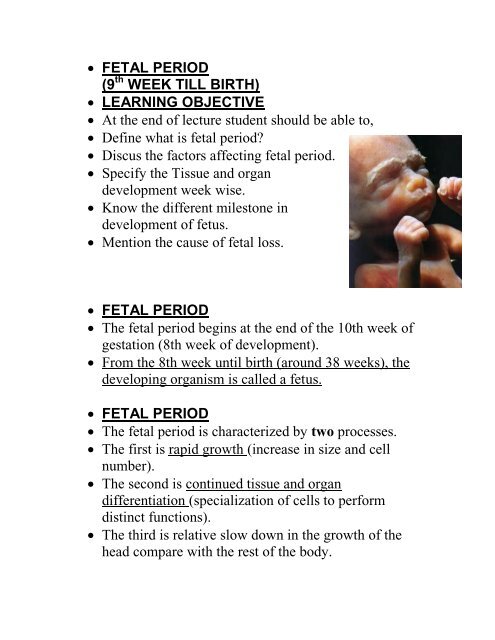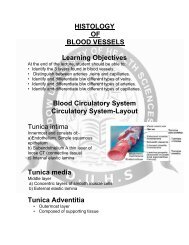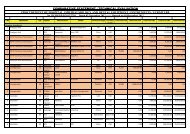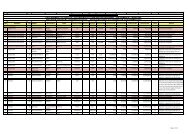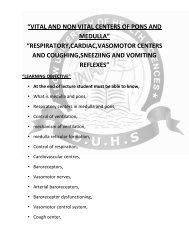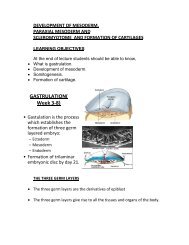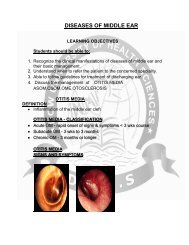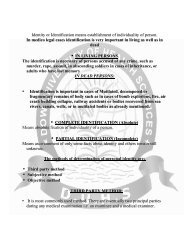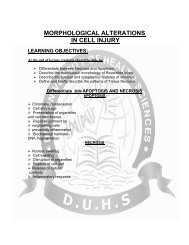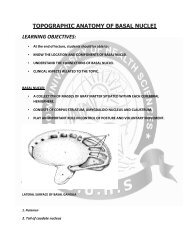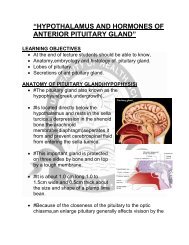FETAL PERIOD
FETAL PERIOD
FETAL PERIOD
Create successful ePaper yourself
Turn your PDF publications into a flip-book with our unique Google optimized e-Paper software.
<strong>FETAL</strong> <strong>PERIOD</strong><br />
(9 th WEEK TILL BIRTH)<br />
LEARNING OBJECTIVE<br />
At the end of lecture student should be able to,<br />
Define what is fetal period?<br />
Discus the factors affecting fetal period.<br />
Specify the Tissue and organ<br />
development week wise.<br />
Know the different milestone in<br />
development of fetus.<br />
Mention the cause of fetal loss.<br />
<strong>FETAL</strong> <strong>PERIOD</strong><br />
The fetal period begins at the end of the 10th week of<br />
gestation (8th week of development).<br />
From the 8th week until birth (around 38 weeks), the<br />
developing organism is called a fetus.<br />
<strong>FETAL</strong> <strong>PERIOD</strong><br />
The fetal period is characterized by two processes.<br />
The first is rapid growth (increase in size and cell<br />
number).<br />
The second is continued tissue and organ<br />
differentiation (specialization of cells to perform<br />
distinct functions).<br />
The third is relative slow down in the growth of the<br />
head compare with the rest of the body.
FACTORS AFFECT <strong>FETAL</strong><br />
GROWTH<br />
Many factors affect fetal growth,<br />
The nutritional state and social habits<br />
(e.g., smoking, drug use) of the<br />
mother.<br />
The state of placental function.<br />
The genetic makeup of the fetus<br />
RAPID GROWTH<br />
Fetal growth rate is greatest at the beginning of the<br />
fetal period (through week sixteen), during which<br />
time the fetus increases twenty-five-fold in weight.<br />
The largest increase in absolute weight gain,<br />
however, takes place during the final month of<br />
gestation.<br />
<br />
TISSUE AND ORGAN DEVELOPMENT
WEEKS<br />
10–12<br />
Gestational age: 9–11 weeks old.<br />
Embryonic age: Weeks number 8–10. 7–9 weeks old.<br />
Embryo measures 30–80 mm (1.2–3.2 inches) in<br />
length.<br />
Ventral and dorsal pancreatic buds fuse during the<br />
8th week<br />
Intestines rotate.<br />
Facial features continue to develop.<br />
The eyelids are more developed.<br />
The external features of the ear begin to take their<br />
final shape.<br />
The head comprises nearly half of the fetus' size.<br />
The face is well formed<br />
The eyelids close and will not reopen until about the<br />
28th week.<br />
Tooth buds, which will form the baby teeth, appear.<br />
The limbs are long and thin.<br />
The fetus can make a fist with its fingers.<br />
Genitals appear well differentiated.<br />
Red blood cells are produced in the liver.
Weeks 13 to 16<br />
Gestational age: 12–15 weeks old.<br />
Embryonic age: Weeks number 11–14. 10–13 weeks<br />
old.<br />
The fetus reaches a length of about 15 cm (6 inches).<br />
A fine hair called lanugo develops on the head.<br />
Fetal skin is almost transparent.<br />
More muscle tissue and bones have developed, and<br />
the bones become harder.<br />
The fetus makes active movements.<br />
Sucking motions are made with the mouth.<br />
Meconium is made in the intestinal tract.<br />
The liver and pancreas produce fluid secretions.<br />
From week 13, sex prediction by obstetric<br />
ultrasonography is almost 100% accurate.<br />
At week 15, main development of external genitalia is<br />
finished<br />
<br />
WEEK 19<br />
Gestational age: 18 weeks old.<br />
Embryonic age: Week numbers 17. 16 weeks old.<br />
The fetus reaches a length of 20 cm (8 inches).
Lanugo covers the entire body.<br />
Eyebrows and eyelashes appear.<br />
Nails appear on fingers and toes.<br />
The fetus is more active with increased muscle<br />
development.<br />
"Quickening" usually occurs (the mother and others<br />
can feel the fetus moving).<br />
The fetal heartbeat can be heard with a stethoscope<br />
WEEK 23<br />
Gestational age: 22 weeks old.<br />
Embryonic age: Week numbers 21. 20 weeks old.<br />
The fetus reaches a length of 28 cm (11.2 inches).<br />
The fetus weighs about 725 g (1 lb 10 oz).<br />
Eyebrows and eyelashes are well formed.<br />
All of the eye components are developed.<br />
The fetus has a hand and startle reflex.<br />
Footprints and fingerprints continue forming.<br />
Alveoli (air sacs) are forming in lungs.
WEEK 27<br />
Gestational age: 26 weeks old.<br />
Embryonic age: Week numbers 25. 24 weeks old.<br />
The fetus reaches a length of 38 cm (15 inches).<br />
The fetus weighs about 1.2 kg (2 lb 11 oz).<br />
The brain develops rapidly.<br />
The nervous system develops enough to control some<br />
body functions.<br />
The eyelids open and close.<br />
The cochleae are now developed, though the myelin<br />
sheaths in neural portion of the auditory system will<br />
continue to develop until 18 months after birth.<br />
The respiratory system, while immature, has<br />
developed to the point where gas exchange is<br />
possible.<br />
WEEK 31<br />
Gestational age: 30 weeks old.<br />
Embryonic age: Week numbers 29. 28 weeks old.
The fetus reaches a length of about 38–43 cm (15–<br />
17 inches).<br />
The fetus weighs about 2 kg (3 lb 0 oz).<br />
The amount of body fat rapidly increases.<br />
Rhythmic breathing movements occur, but lungs are<br />
not fully mature.<br />
Thalamic brain connections, which mediate sensory<br />
input, form.<br />
Bones are fully developed, but are still soft and<br />
pliable.<br />
The fetus begins storing iron, calcium, and<br />
phosphorus.<br />
<br />
WEEK 35<br />
Gestational age: 34 weeks old.<br />
Embryonic age: Week numbers 33. 32 weeks old.<br />
The fetus reaches a length of about 40–48 cm (16–<br />
19 inches).<br />
The fetus weighs about 2.5 to 3 kg (5 lb 12 oz to 6 lb<br />
12 oz).<br />
Lanugo begins to disappear.<br />
Body fat increases.<br />
Fingernails reach the end of the<br />
fingertips.<br />
A baby born at 36 weeks has a high<br />
chance of survival, but may require<br />
medical interventions.
WEEKS 36 to 39<br />
Gestational age: 35–38 weeks old.<br />
Embryonic age: Weeks numbers 34–37. 33–36 weeks<br />
old.<br />
The fetus is considered full-term at the end of the<br />
37th week of gestational age.<br />
It may be 48 to 53 cm (19 to 21 inches) in length.<br />
The lanugo is gone except on the upper arms and<br />
shoulders.<br />
Fingernails extend beyond fingertips.<br />
Small breast buds are present on both sexes.<br />
Head hair is now coarse and thickest.<br />
BIRTH<br />
The process of birth, or parturition (labor), occurs in<br />
three stages.<br />
The first is the dilation of the cervix.<br />
The second is the actual delivery of the fetus.<br />
The third ends with the expulsion of the placenta.<br />
The entire process may take from only a few<br />
hours to well over a day to complete.<br />
The fetus is not as sensitive to damage from<br />
environmental exposures as the embryo, and toxic<br />
exposures often cause physiological abnormalities or<br />
minor congenital malformation.
All major structures are already formed in the fetus,<br />
but they continue to grow and develop.<br />
<strong>FETAL</strong> <strong>PERIOD</strong> GROWTH<br />
The fetus grows dramatically in length and weight<br />
during the fetal period.<br />
The rest of the body grows more rapidly than the<br />
head.<br />
So the relative size of the head shrinks during the<br />
fetal period from roughly ½ to ¼ of the crown-heel<br />
length.<br />
THE MILESTONES OF THE <strong>FETAL</strong> <strong>PERIOD</strong><br />
HEART<br />
sounds can be detected as early as 8 or 9 weeks post<br />
fertilization (p.f.) with a fetal Doppler ultrasound
stethoscope, and 20 weeks post fertilization with a<br />
stethoscope or fetoscope.<br />
An external electronic fetal monitor can be used to<br />
obtain fetal heart rate in the third trimester in<br />
antepartum testing and intrapartum monitoring.<br />
OSSIFICATION<br />
begins at the end of the embryonic period. Most<br />
primary ossification centers of skull, long bones and<br />
vertebrae appear by 12 weeks post fertilization.<br />
The epiphyses of long bones are still cartilaginous at<br />
birth
EXTERNAL GENITALIA<br />
The external genitalia sexually differentiate during<br />
weeks 9-12 post fertilization.<br />
<strong>FETAL</strong> MOVEMENTS<br />
The external genitalia sexually differentiate during<br />
weeks 9-12 post fertilization.
LUNGS<br />
become capable of breathing air at the beginning of<br />
the 3rd trimester (about 25-26 weeks p.f.).<br />
when the lungs enter the saccular phase of<br />
development and begin to produce surfactant.<br />
Lung maturity is the primary determinant of viability.<br />
HEMATOPOIESIS<br />
begins in the bone marrow in the second trimester.
In the third trimester bone marrow replaces the liver<br />
and spleen as the primary site of hematopoiesis.<br />
EMBRYONIC OR <strong>FETAL</strong> LOSS<br />
Embryonic or fetal loss before viability is termed a<br />
miscarriage or spontaneous abortion.<br />
Spontaneous abortion is very common (greater than<br />
50% of pregnancies), especially in the first four weeks<br />
post-fertilization.<br />
Fetal loss after viability is termed stillbirth. Stillbirths<br />
account for 0.5-1% of births.


